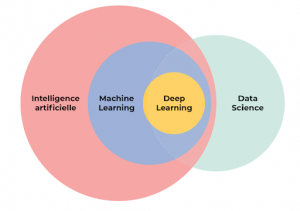In this interview, Hayde Martinez Landa, Data Technology Program Lead, and Heriberto Perez, Technology Director, explain the fundamental concepts behind the Data practice at Wizeline. At Wizeline, this practice is part of an offering known as Intelligence Everywhere. In addition, this interview touches on why focusing on data is crucial for the success of companies of any kind or industry in an ever-evolving world.
Can you tell us a little about the Data & AI practice and how it started?
Hayde: To start, I’d like to note that our Data practice is under the umbrella of the Intelligence Everywhere practice, which is the customer-facing solution. We call it Intelligence Everywhere because we say that data is everywhere, for instance, in applications, personal devices, sensors, industrial machines, and transactions. Most companies haven’t been able to exploit the value of their data, and the vast majority can’t programmatically access their data because it remains in silos and legacy applications. Very few companies have been able to re-architect their data platforms and bring artificial intelligence services at scale. Our Intelligence Everywhere practice brings AI at scale, connecting core business processes with continuously growing and improving data services.
However, at the beginning of Wizeline, when this program was born, we didn’t call it by this name. We began with data scientists in 2015, and we had very few in 2016 when we saw how the market was changing. We created the data engineering role because it didn’t exist here before. We develop and work on data-related solutions for projects and clients, for example, data warehousing, predictive analytics, and models.
What problems does Intelligence Everywhere address for our clients? From your perspective, what is the key differentiator that sets it apart from other offerings or those offered by other vendors?
Heriberto: Putting this in a nutshell, we create or produce actionable insights and recommendations out of raw data. But I think that our differentiator is that we’re putting the insight production process within a continuous value delivery cycle. And to make it actionable, we automate the implementation and measure its results against business results and KPIs. Our unique Continuous Value Delivery Model (CVDM) enables the generation of evermore capitalizable recommendations and insights by embedding the following functionalities within a continuous improvement cycle.
In this cycle, we have a data-driven capability framework that enables the generation of reliable data and evermore sophisticated intelligence products. The hindsight, insight, foresight, and recommendations are derived from processing reliable data through advanced analytic tools that enable machine learning (ML) and AI. After that, we make the AI recommendations “actionable” by streamlining their implementation through the processes of automation, scheduling a plan, and executing it. During the final phase of the cycle, we appraise the worthiness of the AI recommendations by measuring their contribution to attaining tangible business results.
Hayde: Another key differentiator is adjusting to the client’s needs and doing tailored projects for each company and industry. Two examples of this are case studies from a leading global retailer and a fintech client that I’ll explain in a moment.
What is the difference between data, artificial intelligence, and machine learning?

Heriberto: A more business-oriented answer would be that data is the raw material for developing diagnostics and prognostics through machine learning and other data science toolkits. And those diagnostics and prognostics are used by artificial intelligence to infer new knowledge, determine certain behaviors and situations, and provide a recommendation for an end user, given a specific expected outcome. That, I would say, is the difference between the three, and since it requires a lot of tools and investment, it is not a simple process.
What examples of successful client projects have the Intelligence Everywhere team supported?
Hayde: For one project, we worked with an American multinational food manufacturing company. We had three or four data engineers involved and migrated data from on-premises to the cloud. But the team was also multidisciplinary, comprising technical writers and project managers. The project earned an award as one of the year’s best projects for the company.
Another successful client example is from a leading global retailer. They wanted to centralize their data and show it in dashboards to the salespeople, so they could see how much the sales were moving in real-time, which would drive motivation. So we created this dashboard. Once again, this was a multidisciplinary team, including UX design and other roles. This project demonstrates that machine learning, data, and AI alone do magic, but user experience and design are amplified when mixed with other areas. When we don’t notice it “behind the scenes,” it is because it is subtle and creates a seamless experience. Currently, our client has this solution running 24/7, displayed on TVs in their headquarters, and departments interact with it daily, getting actionable insights from the data. Also, more brands and departments are asking for their data to be included since they’ve seen how data can drive people from other departments after interacting with it in real time.
Finally, another client project was with a fintech company focused on student loans. We performed data engineering activities, such as migrating from an on-premises data warehouse to Snowflake and the pipelines from Dagster to Airflow. On top of that, we created a complete CI/CD environment. Now, there is only one source of truth for all the company’s data, and putting predictive models into production can be faster than before. They have reduced a significant amount of manual work in other business areas, saving costs and making processes more efficient. Moreover, our Data Engineering team is still working with the company’s Data Science, Business Intelligence, and Data Analytics teams to develop a solid infrastructure for maintenance. This project was cool, with a lot of top-notch tools!
What would you say to clients questioning the value of integrating data and AI into their operations? Some of them may be skeptical of the power of this worldwide trend toward digitalization.
Heriberto: I think that’s where data-driven strategy comes into place. If your investment and this data science with advanced analytics are aimed at attaining key results for your organization, then the business justification will be there. It will be the same if these key results are aligned with business drivers, such as increased market share, optimized costs, and risk reduction. I think this is not a matter of questioning, “Should I or should I not invest in these technologies?” Instead, it is a matter of considering how these technologies will help me attain my results. And for that part, we are the correct partner to go with.
Hayde: When the cloud was born, every organization could choose between cloud or on-premise. Now, there’s no option. It’s either you’re in the cloud, or you’re out of the market. So I think it’s the same with data. We’re reaching that point where you either have a data strategy or are out of the market. Without data, companies cannot gather the value of what they already have to make better business decisions. This puts them at a disadvantage compared to their competitors and diminishes their productivity and efficiency, resulting in higher costs and processes broken down in silos. This rationale is powerful enough to drive a company to implement a data strategy.
Can you describe the typical roles in the Intelligence Everywhere team?
Hayde: Inside our data program, we have four roles: data scientists, data engineers, data analysts, and business analysts, each with their respective objectives and scopes. For example, we can say that the data engineer is the plumber in charge of the pipelines to ensure the data arrives safe and sound to where it has to be, and it’s not stuck. The data scientist is in charge of using the data that the engineer already provided to create predictive models. The data analyst also works with the data and uses it to create graphic visualizations and reporting aligned to KPIs and business-oriented strategies. And the business analyst is focused on defining and delivering KPIs, objectives, and product stories, all of which focus on data. That is how we define the roles inside the data program. But in a client-facing context, our project scopes may change. Since here we are all generalists, covering, for instance, data engineering or data science, we adapt and adjust to our project or client needs.
Heriberto: In the real world, you will find that all of these data-driven solutions are constantly evolving since they are always in construction. So if you need data operations and governance SMEs, you need to adjust your strategy. That’s where the technical directors and data strategists come into place to accommodate the new business requirements and the new data sources that are coming in to generate better and enhanced insights and recommendations.
What are the requirements for someone interested in joining the Intelligence Everywhere team? What characteristics must a candidate possess to bring value to the customer?
Heriberto: For the roles that require more seniority, you need a combination of technical knowledge and practical use of that knowledge in the field. You don’t need to understand things on a deeper level, but rather how they work on both sides so you can provide the best solutions to the clients. For instance, the solution architect will build the solution based on business interests and technical feasibility.
Hayde: As for the data roles (data engineer, data scientist, data analyst, and business analyst), it depends on the role and the seniority. We currently have the most demand for data engineers. And if you’re looking for this position, you must be strong in programming and data warehousing techniques — which are related to SQL — but also have a basic knowledge of CI/CD for data and, of course, SQL, which is the primary skill of all roles. But if you are interested in data science, you should also have a more profound knowledge of ML algorithms and the creation of predictive models. If you’re interested in becoming a data analyst, it is important to know about reporting tools, visualization tools, and KPI creation, all of which focus on business. And for the business analyst side, you need a business perspective to create KPIs and translate the business needs into specific objectives.
Regarding soft skills, I think you must have a problem-solution mindset because most of the challenges we face are related to being stuck, and we arrive at the solutions later. We thrive on collaboration, critical thinking, and communication to achieve our solutions successfully. Communication, for example, is essential because sometimes our stakeholders are not experts on data, and we have to be able to translate what we achieved or how we did it in non-technical ways.
Are you actively looking for talent?
Hayde: Of course we are. We have a few different roles open right now. We’re looking for technical directors, data engineers, data scientists, and data analysts. We are always looking for talent.
Heriberto: Join the bright side!
Our vision as a company is “We want to be leaders in applied AI — bringing the promise of AI to businesses and global communities, creating seamless digital experiences, products, and platforms that enable businesses to transform.” What is the roadmap to achieve this?
Heriberto: I think we are on the right path. I believe business evolution depends on digital transformation, business innovation, and performance optimization. And the three of them require a lot of data and insights and are streamlined by recommendation engines. So I think we’re very well suited to provide all these enhanced user experiences, new business models, and state-of-the-art operations through data-driven solutions. I believe we are ready to fulfill that mission.
Hayde: I can tell you a little more about the steps we’ve taken until now. First, we defined the statement. And then, we began giving tech and non-technical talks to everyone in the company about this subject because we wanted everyone in the company to be on the same track and speak the same language. Data will soon be standard, something that will be everywhere, and interdisciplinary. Therefore, we need to train non-technical people from all company areas, for instance, the commercial and talent acquisition teams. Since Heriberto joined as technical director, an important step has been his work to create all the practice-related documentation. A third step is that we have our annual Innovation Camp coming later this year, focused on Intelligence Everywhere.
What does the future of AI look like at Wizeline?
Hayde: We all feel very proud about the challenges we have in the program. We are all eager to learn, and the Data team is always proactively taking courses or learning something new. And I think if this trend continues, we will become the best data program in the market. And this will translate into a very positive impact inside and outside Wizeline in the data industry.
Heriberto: I agree with Hayde. I think we are laying the foundations to develop the talent we need to build even more sophisticated analytics and more intelligent applications. So I would encourage everyone interested in building these things to join Wizeline, specifically the Intelligence Everywhere team.
Is there anything else you would like to add?
Hayde: Another key differentiator from our program is the interaction we have as a team. Everyone is willing to volunteer and share knowledge. And this is not something born by itself: we’ve worked on this culture for a long time in our team. And also, we’re not just focused on studying, working, or reading. We also have fun, and I think it’s a great and safe environment, like a family.
To learn more about how Wizeline delivers customized, scalable data platforms and AI tools while making businesses run smarter, download our guide to AI technologies and connect with us today at consulting@wizeline.com to start the conversation.








